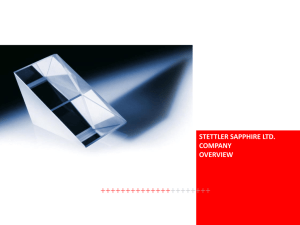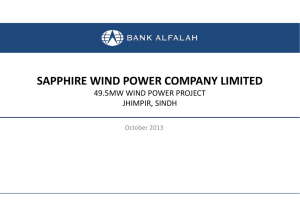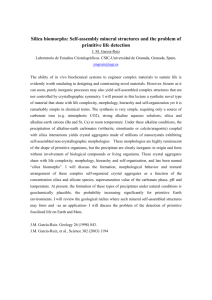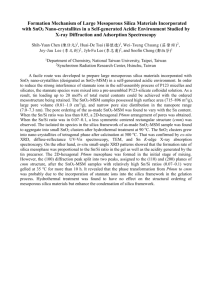Separation of chains in quad suspensions - DCC
advertisement
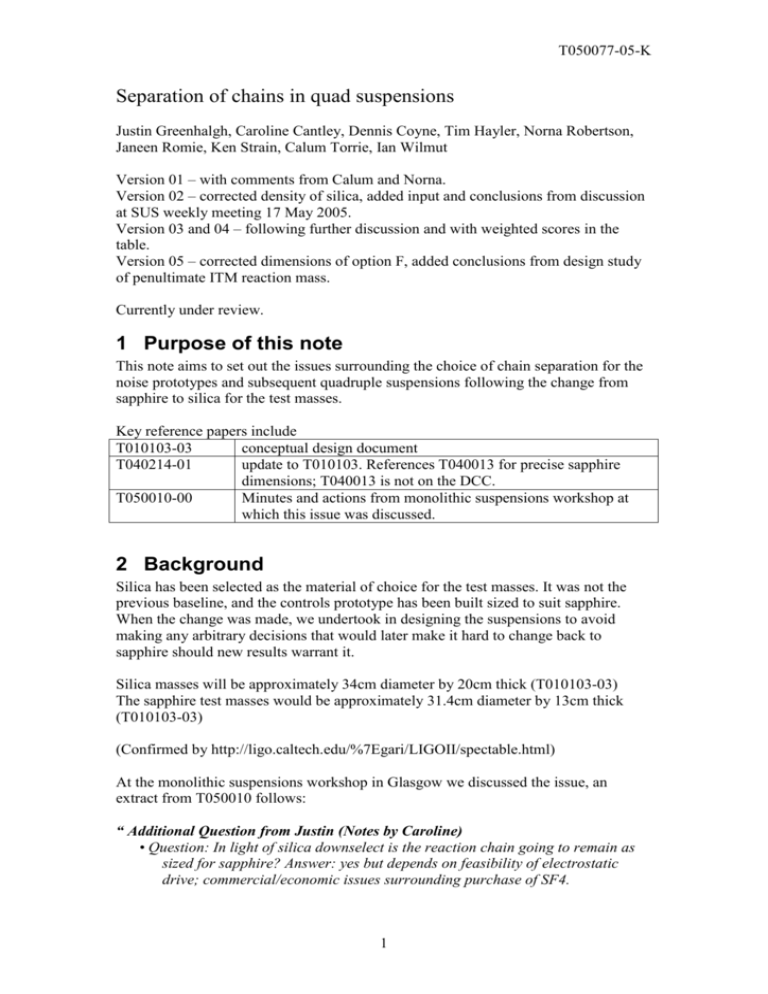
T050077-05-K Separation of chains in quad suspensions Justin Greenhalgh, Caroline Cantley, Dennis Coyne, Tim Hayler, Norna Robertson, Janeen Romie, Ken Strain, Calum Torrie, Ian Wilmut Version 01 – with comments from Calum and Norna. Version 02 – corrected density of silica, added input and conclusions from discussion at SUS weekly meeting 17 May 2005. Version 03 and 04 – following further discussion and with weighted scores in the table. Version 05 – corrected dimensions of option F, added conclusions from design study of penultimate ITM reaction mass. Currently under review. 1 Purpose of this note This note aims to set out the issues surrounding the choice of chain separation for the noise prototypes and subsequent quadruple suspensions following the change from sapphire to silica for the test masses. Key reference papers include T010103-03 conceptual design document T040214-01 update to T010103. References T040013 for precise sapphire dimensions; T040013 is not on the DCC. T050010-00 Minutes and actions from monolithic suspensions workshop at which this issue was discussed. 2 Background Silica has been selected as the material of choice for the test masses. It was not the previous baseline, and the controls prototype has been built sized to suit sapphire. When the change was made, we undertook in designing the suspensions to avoid making any arbitrary decisions that would later make it hard to change back to sapphire should new results warrant it. Silica masses will be approximately 34cm diameter by 20cm thick (T010103-03) The sapphire test masses would be approximately 31.4cm diameter by 13cm thick (T010103-03) (Confirmed by http://ligo.caltech.edu/%7Egari/LIGOII/spectable.html) At the monolithic suspensions workshop in Glasgow we discussed the issue, an extract from T050010 follows: “ Additional Question from Justin (Notes by Caroline) • Question: In light of silica downselect is the reaction chain going to remain as sized for sapphire? Answer: yes but depends on feasibility of electrostatic drive; commercial/economic issues surrounding purchase of SF4. 1 T050077-05-K • Sapphire reaction chain was the easiest option in the first place from footprint considerations and it makes the masses up the top closer together • But the penultimate mass in main chain will be resized and will be made of silica as a result of the silica downselect.” But note that we are currently leaning towards SF2 rather than SF4. Densities are: SF2 SF4 Silica Sapphire 3860 (email Norna and T040013-06) 4790 (email Norna and T040013-06) 2200 (email Norna) 3980 (T040013-06) 3 Discussions Key points from email and telecon exchanges have been: ideally, it would be nice for the reaction mass (RM) to have the same mass as the test mass (Test M). However, we know this will not be so in the ITM because the RM will be replaced by the lightweight thermal compensator plate (TCP). However, as a bare minimum we must ensure that the combination of (Test M + main penultimate mass) is the same as (RM or TCP + reaction penultimate mass) so that the springs and so on in the masses higher up can be the same in both chains, saving design cost. The narrower masses (Top mass, upper intermediate (UI) mass) associated with a sapphire suspension will have lower moments of inertia than those sized for a silica suspension. This means that the design of the pendulum parameters is compromised, though not fatally. The top mass and UI mass, being smaller for sapphire than for silica, will present greater design challenges in fitting in all the parts – however given that we have a controls prototype design these problems have been solved, perhaps at some cost in ease of assembly and/or manufacture. The greater the separation between the upper intermediate mass and the upper intermediate reaction mass, the greater will be the need to put the OSEMs or magnets on “stalks” thus increasing their vulnerability to damage. But note that o it is the chain separation – NOT the size of the masses, that governs the extent to which a tilt of the masses gives a lateral misalignment of the OSEMs. o Note also that there will be no LED/detector pairs in these locations. o Finally, note that the separation of the penultimate mass and its reaction mass will be same (nominally 5mm) for sapphire, silica, or a mix – provided that in all designs the penultimate mass in each chain is the same thickness as the mass below it. 2 T050077-05-K Because sapphire is smaller in diameter than silica, the size of face available for ESD is smaller in a silica/sapphire mixed suspension than in a “pure silica” sized suspension. There would also be an issue of how to design the stops that go between the two if they were different diameters. One could make the reaction mass silica diameter and sapphire thickness given a suitable density material. We need to be sure that whatever chain separation we choose allows for the extra-massive penultimate mass of the compensator plate. As noted in section 5, a sapphire-sized piece of stainless steel has a mass of around 80kg so there should be no problems there. CEIT pointed out that it might be possible to reverse a suspension of, for example, type D if we decided to switch back to sapphire. So the former main chain would become the reaction chain and vice-versa. We should also bear in mind that any sapphire suspension would not need to have identical chains like the C Ptype – so that an option like option F could be switched to sapphire without changing the chain separation: A silica test mass would use a thick main chain and thin reaction chain; a sapphire test mass would use a thin main chain and thick reaction chain. Commonality of non metal masses is not an issue e.g. in option F non metal masses have different sizes but this does not present a procurement problem. All the options fit into the SUS structure envelope, D050266. 3 T050077-05-K 4 Diagrams With apologies to those who can draw. Non-metal masses are coloured. “separation” “gap” “footprint” A B C D Controls Ptype TM = 314 x 130 RM = 314 x 130 PU = 314 x 130 PUR = 314 x 130 “Separation” = 135mm “Gap” at all stages = 5mm “Footprint” = 265 All silica TM = 340 x 200 RM =340 x 200 PU = 340 x 200 PUR = 340 x 200 “Separation” = 205mm “Gap”at all stages = 5mm “footprint” = 405 Silica lower, sapphire upper TM = 340 x 200 RM =340 x 200 PU = 340 x 200 PUR = 340 x 200 “Separation” = 205mm “Gap” = 5mm (bottom), 75 (top) “footprint” = 405 (bottom), 335 (top) Mixed TM = 340 x 200 RM =314 x 130 PU = 340 x 200 (?) PUR = 314 x 130 (?) “Separation” = 170mm “Gap” at all stages = 5mm “footprint” = 335 4 E Mixed, RM sapphire sized TM = 340 x 200 RM =314 x 130 PU = 340 x 200 (?) PUR = 314 x 130 (?) “Separation” = 170mm “Gap” = 5mm (bottom), 40mm (top) “footprint” = 335 (bottom), 300 (top) F Mixed, RM thickness and silica diameter TM = 340 x 200 RM =340 x 130 PU = 340 x 200 (?) PUR = 340 x 130 (?) “Separation” = 170mm “Gap” = 5mm (bottom), 40mm (top) “footprint” = 335 (bottom), 300 (top) T050077-05-K 5 Table of masses A few examples, many more could be done, of course: material silica sapphire SF2 SF4 SF2 density 2.20 3.98 3.86 4.79 3.86 diameter 340 314 314 314 340 thickness 200 130 130 130 130 mass 39.9 40.1 38.9 48.2 45.6 Application Silica TM, RM, etc Sapphire TM RM for sapphire? unknown unknown 3.97 3.39 314 340 130 130 40.0 40.0 RM for silica RM for silica Stainless 7.90 314 130 79.5 PU for TCP RM for silica? 5 T050077-05-K 6 Table of pros and cons Scores are given in an attempt to arrive at a weighted optimum. The maximum score allowed for an area is given in the left-hand column. For example, suspension parameter optimisation has a weight of 5 so that is the maximum allowable score in that line. Option B Option C Option D Option E Option F Better optimised (5) (5) OK at the top, large at the bottom. (5) Design flexibility (10) All new masses required for Sapphire (0) Would need new RM etc for sapphire –at least two new masses (7) At least top masses are the same in both chains (3) As D, but footprint at top is smaller yet which might help with upper structure. (10) Easiest to switch to sapphire (two new masses in main chain) (best) (10) As E (3) Largest required space (0) Worst possible (asymmetric)? (0) Smaller (better) (8) ESD (5) Can use full size of silica mirror (better) (5) As B (5) As D (0) As B (5) Design ease (10) Easier – except that we intend to re-use the C Ptype design as far as possible (0) Best (5) Harder for top masses (but already done for C Ptype, so actually easier) (10) Worst (0) As C but inter-mass earthquake stops harder (7) As C (10) Best (5) Intermediate (3) Intermediate (3) 15 30 18 33 38 Item (weighting) Suspension parameters (5) Footprint (10) OSEM lever arm (gap at UIM) (5) Total scores (out of 45) Would need four new masses in main chain unless you switch the test and reaction chains (7) Can only use 31.4 diameter unless we make a hybridtype RM. (0) Worst of both worlds. (0) 6 As E (10) As C or maybe E (7) T050077-05-K 7 Conclusions The provisional conclusion is that we should use option E or F on the basis of minimising the “footprint” and keeping design flexibility. Option F gives the advantage of a single mass diameter in the lower structure and so is likely to save design costs. A design study has been done to see whether the above options, specifically option F, are compatible with an ITM structure. An ITM structure will incorporate a light weight thermal compensator plate in the reaction chain and consequently need a penultimate mass of approximately 70kg. A preliminary design for the ITM penultimate mass shows that we can achieve 70kg in a volume of material 340mm x 130mm, therefore option F remains the best option. 7
